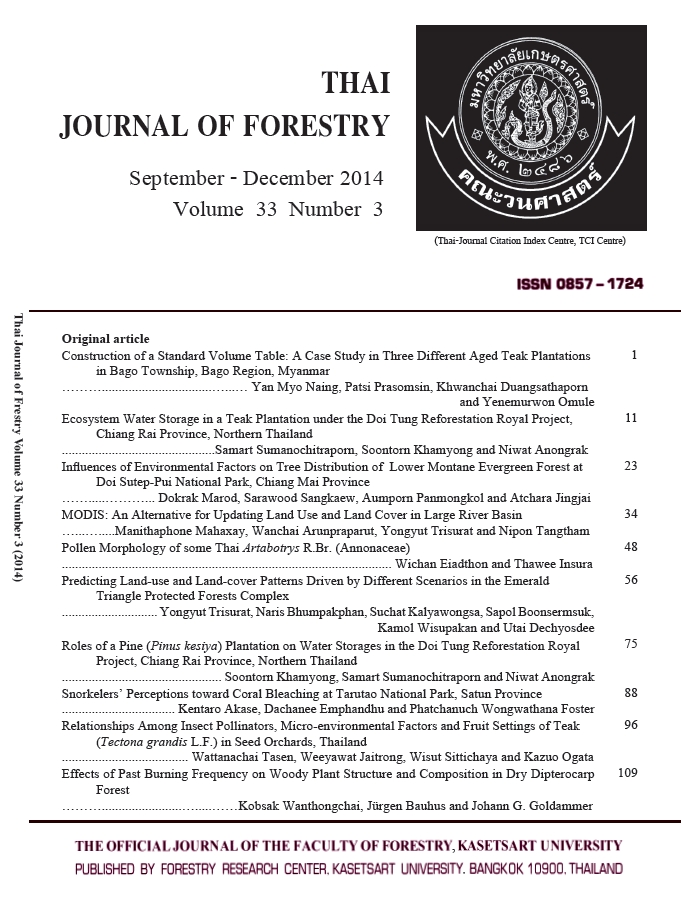Effects of Past Burning Frequency on Woody Plant Structure and Composition in Dry Dipterocarp Forest
Main Article Content
บทคัดย่อ
Anthropogenic burning in dry dipterocarp forests has become a common phenomenon throughout Thailand. Too frequent fires may affect plant species composition, soil properties and processes, and nutrient dynamics, thereby impacting upon ecosystem productivity and sustainability. Conversely, complete fire exclusion, may result in changes to ecosystem components, and an increased risk of high-intensity wildfire. This study aimed to investigate the effects of different burning histories (7, 2, 1 or 0 fires in the past 10 years) and prescribed fire on sites with different past burning regimes on woody plant structure and composition in a dry dipterocarp forest at Huai Kha Khaeng Wildlife Sanctuary, Thailand. Each burning history comprised of three 30m×30m plots for the measurement of overstorey vegetation. Four 4m×4m subplots were set up within the plot to assess saplings and seedlings. These investigations were measured both pre-burn and one-year post-burn. The study revealed that the structure of stands that had been frequently burned in the past differed from that of the less frequently burned stands. Moreover, the species composition of the small-sized overstorey vegetation in the frequently burned stands also differed significantly from that of the other stands. The species composition of the unburned site differed from that of the other burning regimes only modestly. Frequent burning also resulted in a reduction of the sprouting capacity of seedlings and saplings, inhibited regeneration and, consequently, resulted in a disproportionate representation of individuals of certain tree species at the various stages of development. Therefore, fire-free intervals of at least 6-7 years should be introduced to facilitate the successful recruitment of young trees.
Keywords: Burning frequency, Dry dipterocarp forest, Huai Kha Khaeng Wildlife Sanctuary, Prescribed fire, Woody plant
Downloads
Article Details

อนุญาตภายใต้เงื่อนไข Creative Commons Attribution-NonCommercial-NoDerivatives 4.0 International License.
ข้าพเจ้าและผู้เขียนร่วม (ถ้ามี) ขอรับรองว่า ต้นฉบับที่เสนอมานี้ยังไม่เคยได้รับการตีพิมพ์และไม่ได้อยู่ในระหว่างกระบวนการพิจารณาตีพิมพ์ลงในวารสารหรือสิ่งตีพิมพ์อื่นใด ข้าพเจ้าและผู้เขียนร่วม (ถ้ามี) ยอมรับหลักเกณฑ์และเงื่อนไขการพิจารณาต้นฉบับ ทั้งยินยอมให้กองบรรณาธิการมีสิทธิ์พิจารณาและตรวจแก้ต้นฉบับได้ตามที่เห็นสมควร พร้อมนี้ขอมอบลิขสิทธิ์ผลงานที่ได้รับการตีพิมพ์ให้แก่วารสารวนศาสตร์ คณะวนศาสตร์ มหาวิทยาลัยเกษตรศาสตร์ กรณีมีการฟ้องร้องเรื่องการละเมิดลิขสิทธิ์เกี่ยวกับภาพ กราฟ ข้อความส่วนใดส่วนหนึ่ง หรือ ข้อคิดเห็นที่ปรากฏในผลงาน ให้เป็นความรับผิดชอบของข้าพเจ้าและผู้เขียนร่วม (ถ้ามี) แต่เพียงฝ่ายเดียว และหากข้าพเจ้าและผู้เขียนร่วม (ถ้ามี) ประสงค์ถอนบทความในระหว่างกระบวนการพิจารณาของทางวารสาร ข้าพเจ้าและผู้เขียนร่วม (ถ้ามี) ยินดีรับผิดชอบค่าใช้จ่ายทั้งหมดที่เกิดขึ้นในกระบวนการพิจารณาบทความนั้น”


